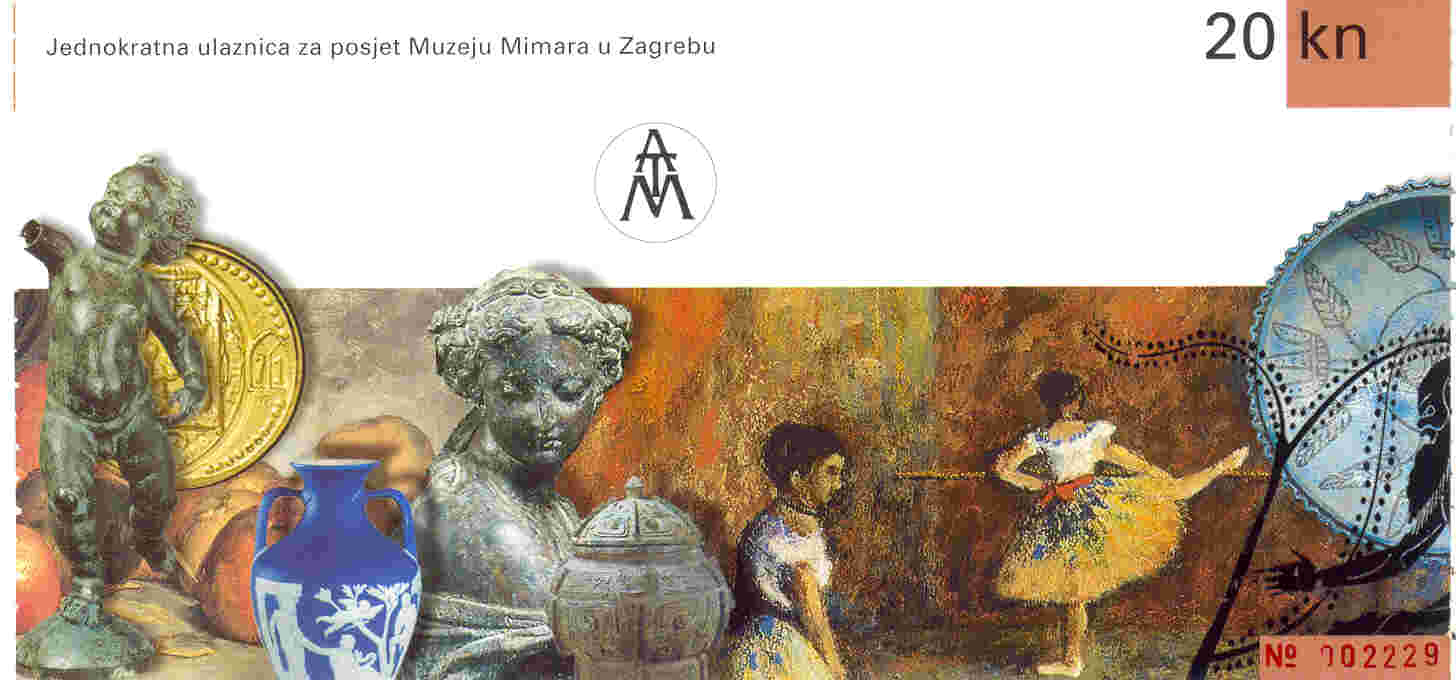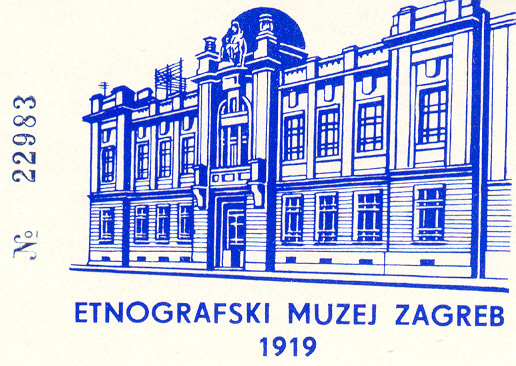Zagreb - Donji Grad
| Like Kaptol and Gradec, the history of Donji Grad is interwoven with the history of Zagreb and its Old Town. I have included a detailed history for the entire city on an associated page. |
The lower terminus for the funicular is located just north of Ilica, the tramway that is the city's main shopping street. I walked along the street a couple of times, but never ventured into many of the stores. I wasn't in a shopping mood during my stay in Zagreb. I did enter two - a sporting goods store to buy a jersey of the national football (soccer) team and the Nama department store to buy postcards to send back to the States.
I headed east on Ilica and came to the Trg bana Josip Jelačić, which is the city's main square. Originally, during the rule of the Hungarian kings, the square was the collection point for taxes. From this role, the square was known as "harmica", which is a derivative of the Hungarian word for 1/30th - the tax rate at the time. In 1641, the annual fairs were moved to the square from their locations in Gradec. In the 1850s, the square was designed in its present format. The equestrian statue of 19th c CE viceroy Josip Jelačić was added in 1866. Jelačić became a national hero in 1848 when he secured Croatian self-determination rights from the Austro-Hungarian empire. Unfortunately, these rights eroded over time, so his victory was short-lived.
|
|
| The statue of Ban Jelačić, in the center of his namesake square |
The square is a great place to observe people and watch the world go by. I passed through the square a number of times, and it always seem to have activity of one sort or another. I spent the second afternoon in the square just watching people - lovers meet, teenagers goof around and old ladies chatting. It was a nice way to kill an hour.
|
|
|
| Looking northwest from the square's southeast corner. The Jelačić statue can be seen on the far right side of the picture. | Looking almost due west from the square's southeast corner. Notice the tram lines that run on Ilica. |
I headed south from the square on Praška, which also has a number of tram line running on it. About a block south of the square, the street forms the western border of the Trg N Šubića Zrinjskog. It is a lovely square surrounded by birch trees. There is a gazebo in the center, which I'm sure hosts concerts in the summertime. There are fountains in three of the four quadrants (the northeast quadrant does not have one).
|
|
| The water fountain in the center of Trg N Šubića Zrinjskog |
At the southern edge of the square is the Strossmayerova Galerija Starih Majstora, which is housed in the Hvratska Akademija Znanosti i Umjetnosti (Croatian Academy of Arts of Sciences) building. The museum's most important piece is the Baščanska Ploča, a rock tablet from the island of Krk that is written in the Glagolitic text. Dating from the early 12th c CE, it is the oldest known sample of the script that Saints Cyril and Methodius codified the Slavic language in the middle of the 9th c CE. The slab is housed in a glass case on the building's ground floor. Entry to the museum, which costs HRK 20, is not required to view the tablet.
Behind the academy's building is Strossmayerov trg, named for the illustrious Roman Catholic bishop and avid art collector. There is a statue of the bishop in the square, which is hidden from the public view. The park was filled with lovers engaging in foreplay-type activities - the girl would sit on the guy's lap while kissing him; the rhythmic motion I'm sure simulated sex. Get a room already!
The next major building is the mustard-colored Umjetnički Paviljon, which appears to be in need of a good coat of paint. The pavilion hosts special art exhibits; during my visit, it was hosting an exhibit of works by Vatroslav Kuliš entitled Riffovi. I did not see the exhibit. South of the pavilion is the Trg kralija Tomislava, named for the king who, in the early 10th c CE, united Dalmatia with the Croatian interior. The area in his kingdom included modern Bosnia, Croatia and Montenegro. Consequently, he is viewed as the father of the Croatian nation. There is a statue of the great king in the middle of the square. To the south is Zagreb's main train station.
|
|
|
| The Umjetnički Paviljon | The statue of kralija Tomislava |
I headed west on Trenkova, which turns into Žerjavićeva, then Vukotićeva. This last street intersects Savska cesta at Rooseveltov trg, which is named for the thirty-second president of the United States. This plaza sits in front of the nation's preeminent art museum, the Muzej Mimara. The museum displays the former private collection of Ante Topić Mimara. Born on 07 April 1898, he began collecting art while in Italy. His first piece was an ancient Christian chalice. In 1967, he donated 140 pieces of art to the Strossmayer Museum. Five years later, he started to transition his entire 3750-piece art collection to a new museum in Zagreb. Unfortunately, he died in 1987, shortly before the museum opened to the public.
|
|
| The neo-Classical former school that now houses the Muzej Mimara |
His collection now is housed in forty rooms on three floors of this former school building. Some highlights include:
| Ground Floor | ||
| Room 2 | Islamic art, mainly glass pieces with beautiful Arabic script | |
| Room 6 | Carpets from the 17th to 19th c CE. There is one carpet on the north wall that is beautiful, with deep reds, blues and yellow. It originates from Bursa, which is located just outside of Istanbul. | |
| First Floor | ||
| Room 15 | This room contains a wooden altar and church seat from 14th c CE England. | |
| Room 20 | The center of the room is dominated with a wooden carving of the Archangel Gabriel - Arkandeo Gabrijels andelima - that originated in 15th c CE Flanders (Belgium). | |
| Room 22 | On the west wall, there is a leather church from 16th c CE Tuscany. | |
| Second Floor | ||
| Room 30 | This room displays Russian iconography. | |
| Room 35 | This is a large room with a high ceiling. It displays some of the museum's prized possessions, including a couple of works by Dutch artist Rembrandt. | |
| Room 38 | In this room are works by Spanish artist Velázquez. | |
| Room 39 | Works on display here include some by the Italian artist known as Canaletto. | |
| Room 40 | In the middle of this room is a work by Renoir. On the reverse side is a painting entitled Kupčica Djevojka u Molitvi. | |
| Room 41 | In this room are works by Impressionists Seurat, Pissarro and Degas. | |

I highly recommend a visit to this museum. At the time of my visit (May, 2003), the entrance fee was HRK 20 and the hours of operation were daily from 10.00 to 17.00. Unfortunately, the museum does not maintain a website.
There are two additional museums in this area. Both museums have a specialized collection, so, unless the visitor is interested in the subject matter, entrance is not required. The first is the Muzej za Umjetnost i Obrt, which serves as the country's arts and crafts museum. The three-story building is impressive, with an outstanding grand staircrase. Each of the museum's rooms are devoted to a different period, including Gothic, Renaissance, Baroque and Rococo on the ground floor to Art Deco and 20th c CE on the first floor. The sacred art collection on the first floor is impressive, including three altars: Sv Marije (1460), Sv Stejepana Prvomucenika and Sv Ladislav. The third floor has an entire room devoted to church bells.
The second museum, which is located around the corner, is the Etnografski Muzej Zagreb. On the first floor, the museum was displaying a special exhibit on Istra, the peninsula on the Adriatic Sea. The exhibit was limited to pictures and a few local costumes. The remainder of the museum displayed costumes unique to the country's various towns, villages and provinces. Unless the visitor has a fascination with local costumes, then the HRK 15 is not worth it.
|
|
|
| The front of the Etnografski Muzej Zagreb | Entrance ticket to the museum |
Return to the Zagreb
Main Page or the Croatia Main Page
